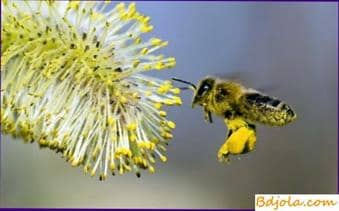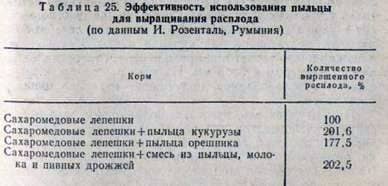
Use perga, folded into a honeycomb.
To obtain pergi, beekeepers use the old honeycombs culled (in autumn and spring). With the autumn culling of honeycombs, you can select all the frames (only from healthy families) that contain a lot of perga.
To get a small amount of perga, the honeycomb is cut into strips so that each cell is cut. Then they shake hands with the lumps of honeycomb to separate the perga from the honeycomb cells. The selected pergu is immediately ground with an equal amount of honey and stored in a sealed container until consumed.
At present, a more productive way of extracting perga from honeycombs has been developed. Some beekeepers in the Baltic republics have even organized the production of a honey-pear mixture for sale. To do this, the apiary is placed in small groups-for 20-30 families-in one place to facilitate the transfer of pollen to bees. In the midst of a good transfer of bees by bees, the beekeeper travels around groups of hives and takes away from the strong families 1-2 honeycombs, most full of penguins. In their place puts empty honeycombs or frames with a wax. As experience has shown, bees quickly restore the selected honeycomb, and empty fill with perga. Under favorable conditions, pergu is selected 2-3 times per season.
Experience has shown that selection from a family of 3-4 honeycombs per season does not reduce honey productivity of the apiary.
Of the selected honeycomb with perga, the honey is pumped out and put up for several hours near the apiary, so that the bees “drained” the honeycomb, that is, completely freed them of the remnants of honey. Then the honeycombs and perga are transported to processing points. They are first placed in chambers through which dry warm air is passed. The particles of pollen in the chamber dry up and lag behind the walls of the cells. For their extraction, the honeycomb is crushed in crushers so as to release the lumps of perga from the wax walls of the cells. To get a clean update use a machine that resembles a conventional winnowing machine. Heavy lumps of pollen fall near the winnowing machine, and the light wax walls of the cells fly away to a farther distance. Part of the mixture, not completely freed from the wax particles, is passed through the winnowing machine again.
Pergu is mixed with honey in equal proportions, thoroughly ground to a uniform mass and packaged in a glass container, which is hermetically sealed with lids. Such honey-pergovaya paste is used not only for feeding bees, but also for medicinal purposes.
Collecting pollen from plants.
Experiments were conducted to collect pollen from plants, which give it in large quantities. Of particular interest is hazel (hazel), it blooms early in the spring (before the appearance of leaves). Earrings of hazel are harvested at a time when they are sufficiently ripe, but the pollen from them is still not shaken.
Collected earrings dice are introduced into a warm room with a temperature of 20-25 њ C and laid out on plywood or sheets of the newspaper in a layer of 2-3 cm. Drying, the anthers burst, and the pollen spills out. Once or twice a day the earrings are turned over. Pollen, poured from the earrings, is collected on paper.
Another plant with which the experience of collecting pollen – corn was conducted. In a warm, windless morning, passing through the field with buckets or large jars, they tilted the panicles of corn and shook off the pollen from them. In the morning, one worker can collect up to 800 g of pollen. According to the data, maize pollen contains 14.2% protein, 2.3% fat and a very large amount of vitamin C (4.1 mg%).
The collected pollen is sieved through two sieves (the first is coarse and the second one with holes of 0.2 mm), after which it is spread by a layer of 2-3 cm onto sheets of plywood for drying at a temperature of 20-32 њ C.
The collected pollen, brought to an air-dry state (0-5% of water), can be stored in glass jars with paraffin plugs and polyethylene bags.
Pollen harvested from corn and hazel was tested for the effectiveness of use for brood rearing in early spring. The experiments were conducted for 3 years on 30 families. Control families received cakes of sugar, mixed with honey. Experienced families received, in addition to Saccharum cakes (2 kg each) more. 150 g of pollen mixed in the form of a honey-dust mixture. During the early spring period, the experimental families fed much more brood than the control ones (Table 25).

The data in Table 25 indicate a greater efficacy of pollen collected manually from corn to grow the brood in the spring.
With the appearance of pollen from plant flowers in nature, the difference in favor of pollen-fed families declined slightly and amounted to 12-25%. By May 3, the mass of families by 11.5-13% exceeded the number of control families.
According to the chemical composition of the pollen of corn is close to the pollen of fruit trees, forest chestnut, meadow clover and white acacia.
In Romania, experiments were also conducted on manual collection of pollen from maple, willow, sorghum, pine, sunflower, pumpkin and other plants. The chemical analysis of collected pollen showed that the pollen of willow is especially rich in protein (40.8%), pumpkin (35.0%), sunflower (27.4%). The pollen of maple contains 18.5% protein, pine-13.5%. The admixture of such pollen to the artificial protein feed greatly increases the bees eaten by the bees and the efficiency of the feeding process.
Как правильно наващивать вощину. Нуклеусы для зимовке маток.
Feeding base of beekeeping